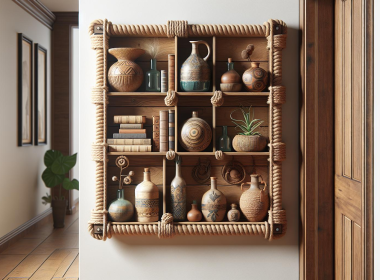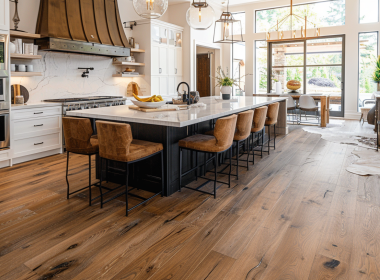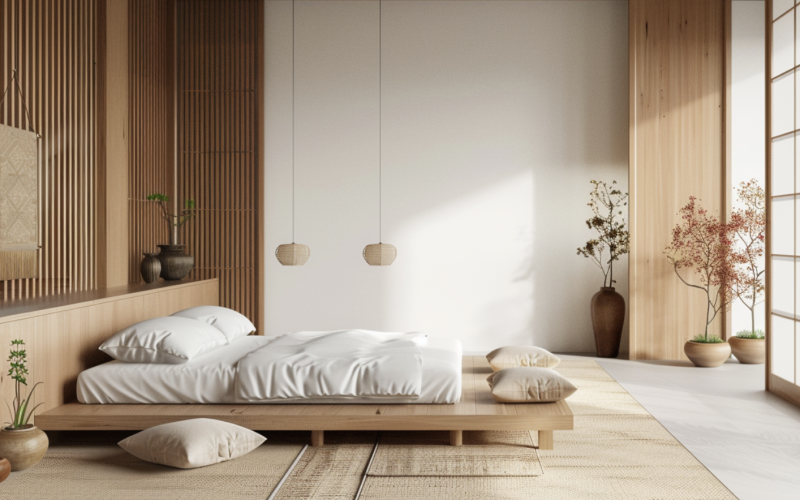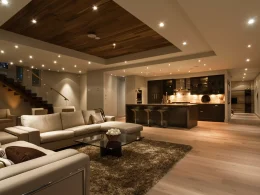Imagine stepping into your bedroom and instantly feeling a sense of tranquility and harmony. That’s the power of a well-styled Japanese bedroom.
If you want to create a serene, minimalist bedroom, incorporate Japanese design elements.
In this blog post, we’ll explore how you can transform your space into a peaceful retreat by embracing the principles of Japanese interior design.
From choosing the right color palette to incorporating natural materials and decluttering your space, we’ll guide you through the essential steps to achieve a Zen-like atmosphere in your bedroom.
Get ready to discover the beauty and simplicity of Japanese-inspired decor and learn how to create an aesthetic bedroom that promotes relaxation and mindfulness.
Let’s dive in and explore the art of styling a Japanese bedroom!
Zen Philosophy
Zen, a school of Mahayana Buddhism, emphasizes meditation and insight into Buddha’s nature and expresses this insight in daily life to benefit others.
Zen philosophy prioritizes tranquility and simplicity, translating into a Japanese bedroom’s design elements.
These elements reduce stress and enhance peace of mind by creating a calming and uncluttered environment.
Zen principles manifest physically in bedroom design through open spaces, balanced layouts, and subdued colors that promote a calm and meditative environment.
Importance of Minimalism
In Japanese culture, minimalism is known as ‘Ma,’ referring to negative space, quietness, and restraint for effect.
Decluttering is critical in achieving Zen by minimizing distractions and creating a peaceful atmosphere.
Simplicity is not just aesthetic but also functional, influencing the choice of furniture and decor in a Japanese bedroom.
By focusing on functional benefits and choosing fewer but more meaningful pieces of furniture, you can create a space that feels intentional and purposeful.
A Japanese bedroom typically features minimalist furniture such as low beds (futons), tatami mats, and built-in storage that conserves space.
Functional furniture and clever storage solutions maximize space while keeping the room clutter-free and serene.
Key Elements of a Japanese Bedroom
Natural Materials and Colors
In Japanese design, natural materials like wood, bamboo, and linen are preferred for their sustainability, ecological benefits, and harmony with the Zen philosophy of being close to nature.
Natural materials contribute to the bedroom’s ambiance by offering durability, comfort, and a connection to the natural world, which enhances tranquility.
Wood and bamboo, for example, provide stability and groundedness, while linen adds a touch of softness and breathability.
Subdued, earthy colors are crucial in creating a calm environment in a Japanese bedroom.
Colors like beige, soft greys, and pastels create a restful atmosphere and reflect traditional Japanese aesthetics.
Tatami Mats
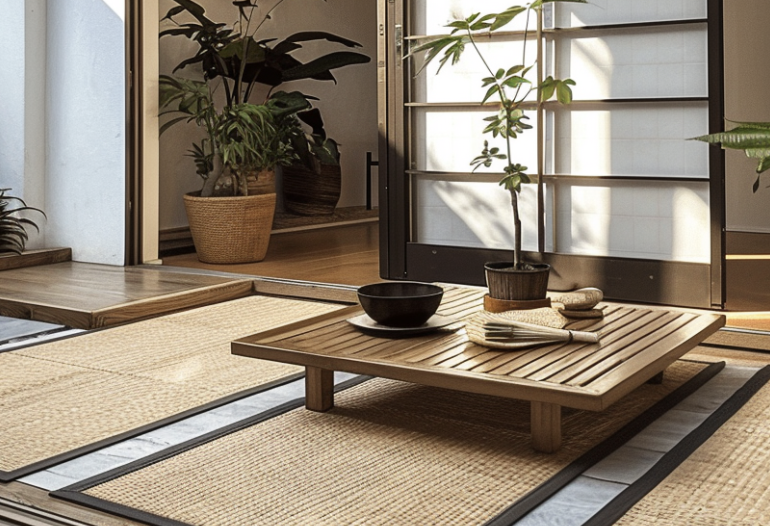
Tatami mats are a quintessential element of Japanese bedrooms. They are made from woven rush grass over a rice straw core.
These mats have traditional significance and are deeply rooted in Japanese culture, symbolizing simplicity and elegance.
Tatami mats enhance a room’s beauty with natural texture and color, adding warmth and depth to the space.
They also offer practical benefits such as insulation, sound absorption, and a comfortable surface for walking and sitting.
Tatami mats add authenticity to the Japanese bedroom theme and offer comfort underfoot, integral to the minimalist lifestyle.
The soft and slightly springy surface of tatami mats provides a pleasant sensation when walking or sitting, encouraging relaxation and connection to the space.
Common Furniture in a Japanese Bedroom
- Low Bed Frames (Futons): Traditional Japanese bedding, easily folded and stored to maximize space and maintain a clutter-free environment.
- Shoji Screens: These are translucent paper and wooden frames used as room dividers or sliding doors, enhancing layout flexibility and privacy.
- Minimalistic Storage Units: These units include low cabinets and tansu chests that provide functional storage while preserving the room’s aesthetic simplicity.
Importance of Functional Storage
- Prevents Clutter: Essential for maintaining the aesthetic simplicity of the room.
- Seamless Design Integration: Minimalist storage units blend with overall decor, keeping belongings organized and out of sight.
- Creates a Serene Space: Helps maintain an uncluttered, tranquil bedroom environment.
Layout Tips Based on Feng Shui Principles
When arranging furniture in a Japanese bedroom, consider the principles of Feng Shui to optimize the flow of energy (Chi) in the space.
Place the bed in a commanding position, diagonally opposite the door, to create a sense of security and control.
Avoid aligning the bed directly with the door, as this is believed to disrupt the energy flow.
Use symmetrical arrangements for harmony, such as placing matching nightstands on either side of the bed or positioning artwork in a balanced manner.
Natural Light
The presence of ample natural light helps to uplift the mood, boost productivity, and promote a sense of connection with the outdoors.
In a Japanese-inspired bedroom, maximizing natural light is essential to maintain a tranquil and refreshing atmosphere.
To maximize natural light in your Japanese bedroom, consider the room’s orientation and the size and placement of windows.
Ideally, the bedroom should have large east or south windows for plenty of morning and midday sunlight.
Avoid heavy, dark curtains that can block light and instead opt for lighter, more translucent window treatments that allow light to filter through while still providing privacy.
Japanese Art and Elements
Incorporating traditional Japanese art and elements, such as calligraphy, adds cultural depth and aesthetic value to the bedroom.
These decorative pieces often feature symbolic motifs that contribute to the overall theme and create a sense of authenticity.
For example, calligraphy art featuring Japanese characters or phrases related to peace, harmony, or nature can reinforce the room’s tranquil atmosphere.
When selecting art pieces, opt for minimalist frames or hanging scrolls that complement the room’s simplicity.
Paper Lanterns and Indoor Plants
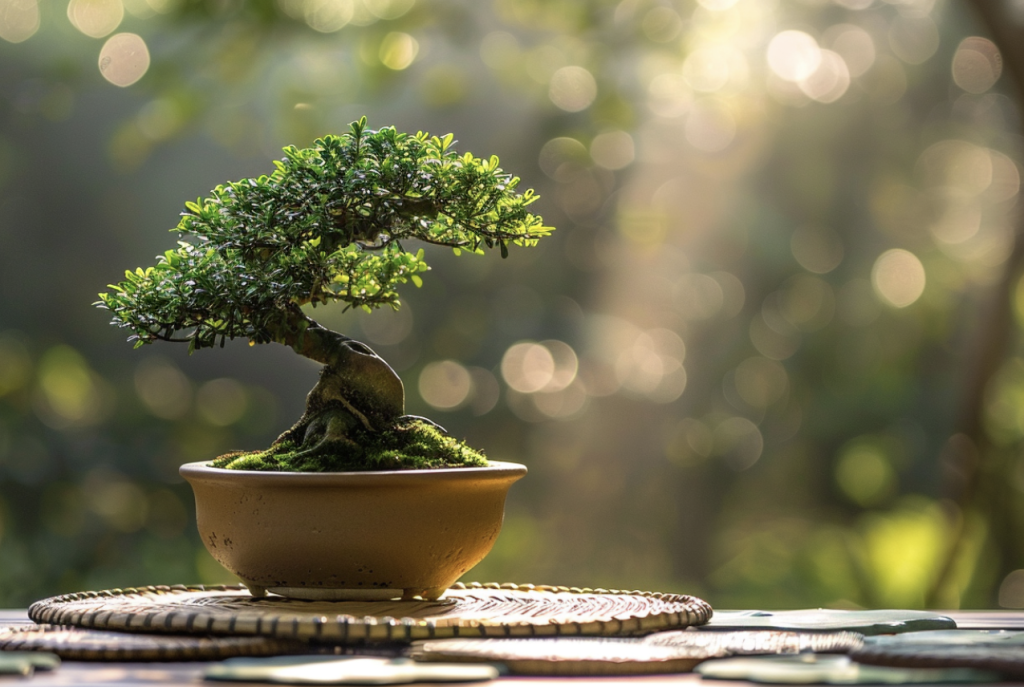
Paper lanterns are popular in Japanese-inspired bedrooms. They provide soft, diffused light that complements the tranquil environment.
These lanterns come in various sizes and shapes, allowing you to create a layered lighting scheme that adds depth and interest to the room.
In addition to paper lanterns, consider incorporating indoor plants like bonsai or bamboo, which enhance the connection to nature and add life to the space.
These plants improve air quality and enhance the room’s serene and refreshing atmosphere.
Summing It Up
Creating a Japanese-inspired bedroom is an excellent way to transform your space into a serene and peaceful retreat.
You can design a bedroom that promotes relaxation and mindfulness by incorporating the core concepts of Zen philosophy and minimalism, along with key elements such as natural materials, tatami mats, and thoughtful lighting.
Remember to keep your space uncluttered, prioritize functionality, and select decorative elements that contribute to the tranquil atmosphere.
As you take on this journey of creating your own Japanese-style bedroom, embrace the beauty of simplicity and let the principles of Zen guide your design choices.
With these tips, you’ll be well on your way to enjoying a restful and rejuvenating space that reflects the timeless elegance of Japanese design.

